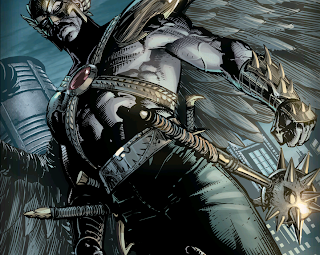Now I, personally, was not particularly hyped for this book. Why? Well, several reasons. First, as much as I like Johns's work, his Justice League has, for the first 14 issues, been mediocre, and other than the entertaining Shazam backup have been a waste of money and talent. Second, the cast of JLA isn't all that interesting to me. Martian Manhunter and Hawkman are cool, I guess, and Simon Baz isn't a terrible character, but why is Katana there? Why Catwoman? Who the hell is Vibe? Why is Johns forcing his 'favorite character', Stargirl, into a politically charged book like this?
Luckily, this book delivers, to put it simply. I'm not sure if it has lived up to the hype for a lot of people, because it takes a rather different approach than what one might have expected after reading Johns's Justice League by Michael Bay, but the approach works. Instead of bombarding readers with a slew of rushed introductions and then forcing some random action sequence, the entire book is actually one long conversation between Amanda Waller (or as I like to call her, Amanda Fencer. Cause she's more of a fence than a wall now) and Steve Trevor, who for some reason has still not gotten over the fact that the daughter of Zeus has turned him down in favor of Superman. In fact, there's quite a few references to his past relationship with Diana, and it often feels forced. Johns realizes that there's more to Steve than just Wonder Woman, right? Because I swear he was more interesting in that one issue of Legion Lost, which is actually saying a lot...
 |
| Hawkman's a badass, something I didn't think was possible after Liefeld's run... |
The art, in its austerity and seriousness of tone, fits perfectly with the story. As I said earlier, this isn't some big, dumb action book, which Justice League has unfortunately been for a large part. From the get go, Johns builds intrigue, introducing both Ivo and another, mysterious villain. Interspersed with the dialogue and flashbacks are scenes of a black garbed, masked individual running for dear life, which adds a sense of tension and buildup to the otherwise steady-paced story. The story itself is rather simple; Amanda Waller is the control freak who wants to build her own Justice League, in case the regular ones goes bad, and Steve, being the hardened, rebellious soldier, is against it. Waller spends the large part introducing the team and convincing Trevor of their place.
 |
| Stargirl discovers Satanism |
Catwoman is given a lot of attention, which is to be expected. I still don't really get why she joined (maybe I'm missing something because I haven't caught up with the current Catwoman run), but her role makes sense. Martian Manhunter and Baz are the typical powerhouses and kinda skimped over, which is fine, since we've already well acquainted with them. The others are given okay motivations and roles, and I still question parts of the lineup, but overall I came out more impressed with this issue than I had expected. The approach worked, and the characterization was, for the most part, top notch. It's true, nothing really happened, but I expect the series to start taking off in the next issue. I think the build-up was necessary, not only to introduce the characters but also introduce what exactly the book was about. Its clear from the get-go that this isn't your regular superhero team-up book. There's a patriotic/political aspect to it that's far more intriguing than anything the New 52 Justice League International could cook up, and all this talk about the 'Secret Society' being rebuilt has definitely got me hooked. There's also the whole deal with the regular Justice League, and there's some foreshadowing that the JLA might need to take them down. The rudimentary match-ups are certainly interesting.
 |
| Good luck Katana |
Writing and Dialogue: 4/5 - An excellent direction and format of storytelling, and some good characterization, make this a fun, exciting read that'll make you want more.
Art: 4/5 - An excellent, realistic take that ties in perfectly with the politically charged nature of the book, with equal amounts of dark and color.
Fan service: 3/5 - Though it's probably not everyone's favorite cast of characters, there's enough backstory and characterization to keep you interested. Also, Martian Manhunter. Nuff said.
Overall: 4/5 - An excellent start to a promising new series that creates a solid foundation for the team and has just enough of a hook to get you to wanting more.



